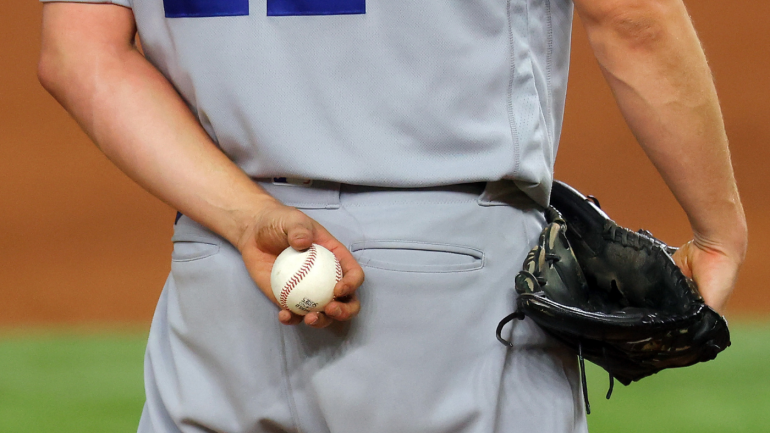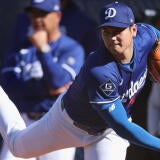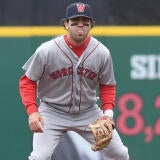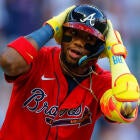
Major League Baseball has issued a memo to all 30 teams regarding the use of foreign substances on baseballs by pitchers, per multiple reports (Joel Sherman of the New York Post was first).
Rule 6.02c reads that the pitcher shall not:
(2) expectorate on the ball, either hand or his glove;
(3) rub the ball on his glove, person or clothing;
(4) apply a foreign substance of any kind to the ball;
(5) deface the ball in any manner; or
(6) deliver a ball altered in a manner prescribed by Rule 6.02(c)(2) through (5) or what is called the "shine" ball, "spit" ball, "mud" ball or "emery" ball. The pitcher is allowed to rub the ball between his bare hands.
(7) Have on his person, or in his possession, any foreign substance. Rule 6.02 (c)(7) Comment: The pitcher may not attach anything to either hand, any finger or either wrist (e.g., Band-Aid, tape, Super Glue, bracelet, etc.). The umpire shall determine if such attachment is indeed a foreign substance for the purpose of Rule 6.02(c)(7), but in no case may the pitcher be allowed to pitch with such attachment to his hand, finger or wrist.
Now, if there are obvious violations, the pitchers generally get caught. We might remember, for example, Michael Pineda pitching for the Yankees with a big patch of pine tar on the side of his neck in 2014. There have been a lot of other, perhaps less-obvious examples, too. Everyone involved knows a large number of pitchers have gotten away with using foreign substances for years in kind of a nudge-nudge-wink-wink atmosphere.
Judging from reports regarding the content of the memo, MLB is now pretty serious on cutting down on the usage of foreign substances on the mound now in a big way. Maybe they can't eradicate it completely, but this is a serious effort. Here's what the league laid out in its memo:
- There will be compliance officers in clubhouses, dugouts, tunnels and pretty much everywhere a pitcher could go to try and apply, say, pine tar to the inside of his hat.
- The league will also take balls out of play and conduct inspections of the baseballs via a third-party lab. (Yeah, science!)
- MLB could investigate significant jumps in a pitcher's spin rate.
Players found to violate the rule will be subject to punishment by the commissioner's office, even if the evidence of the substance is found after the game in question.
Here are five things to consider regarding the fallout of this memo.
1. Interesting timing
The most obvious thing about the timing here is why MLB only announced this with the regular season less than 10 days away instead of immediately before spring training so pitchers can get used to being watched a lot more closely than in previous years. A just as obvious answer would be that they weren't supposed to be doing this anyway, so why did you need time to prepare to not cheat?
Instead, I'm much more concerned with the timing as it relates to the baseballs. There's been lots of talk about the baseballs being different this season in an attempt to make them less "juiced;" a bit more "deadened," so to speak. The appearance here is to decrease the large number of home runs, especially cheap ones, meaning it benefits pitchers and hurts hitters.
Attacking the substances issue is a strong move in the opposite direction, hurting pitchers and helping hitters.
Even if it seems like it's more a balance-type thing, it's actually moving both areas toward a greater good. We'll get to that in a bit.
2. Weather plays a factor
Given that a bulk of this game is played in the summer, sometimes pitchers take the mound during the day in extreme heat and/or humidity situations where sweat drips down on their hand and fingertips puts everyone in a less than ideal situation. If a pitcher can throw the ball 100 miles per hour and doesn't have a proper grip, all of a sudden the batter is at risk to take one to the head and suffer a career-altering injury.
There's also the sunscreen defense. That is, during day games, pitchers have been known to throw a little extra sunscreen on parts of their body with sweat (back of the neck, forearm, etc.) and make kind of a sunscreen/sweat paste to doctor the baseball. What to do with this, if you're MLB? They can't exactly force the guys to get sunburn. It'll be interesting to see.
There's also the cold weather in the early months or late in the playoffs to consider. Grips can be compromised with really cold hands, too.
How can MLB strike the proper ground with gripping, sunscreen and doctoring the ball?
3. Statcast steps into the forefront
MLB continues to lean into Statcast data, but this is the first area where it could actually be used to punish players with suspensions. Among the things noted above in the memo, MLB also has told teams it will use Statcast's spin-rate analysis during investigations.
Yes, spin rate -- a darling in advanced-metric circles these last few years -- is about to get its mainstream introduction to the casual fan.
4. Spin rates
For years, pitchers getting away with using foreign substances has flown a bit under the radar in the public eye. In recent years, controversy has started to mount as there is evidence that using a foreign substance helps to increase the spin rate of a pitch. Extra spin can lead to extra velocity and movement -- especially now that the elevated seams appear to be back -- and, as such, can lead to more effective pitches.
Trevor Bauer actually discussed the matter at length in 2018 while insinuating -- but being careful enough to not outright accuse -- the Astros of exploiting the use of foreign substances to get more spin from their pitchers. Those Astros teams did have a knack for acquiring pitchers and either turning decent pitchers into good ones or sending good ones straight into overdrive.
Next time out, this happened with Bauer:
Bauer's 4-seamer had a spin rate of 2,597 RPM in 1st inning of last start, compared to a 2,294 season average. Had "no comment" on whether he used a substance on the ball, but noted that his research shows a 200-300 RPM jump on higher-velocity pitches when a substance is used.
— Jordan Bastian (@MLBastian) May 2, 2018
It's worth mention that Bauer's 2020 spin rates, when he won the NL Cy Young, jumped huge in average from 2019, too, when he was mediocre.
That is to say, there seems to be something to faster spin.
There have been studies, as Bauer noted in the above tweet, that foreign substances help increase it.
5. Less strikeouts?
And that brings us to strikeouts.
It's been greatly discussed the last several offseasons how MLB has a problem with three true outcomes (home runs, strikeouts and walks) becoming far too prevalent during each game and how more on-field action is needed. Home runs are really fun to watch, strikeouts can be outstanding in key spots and walks are great for the offense, but a true action-packed game has a lot more defense and baserunning, leading to close plays on the bases.
With the home runs issue, MLB is working on the baseball. We've already discussed that. The yin to the yang here -- we're doing something to hold hitters back, so let's do the same to pitchers -- is cutting out the foreign substances. If the excessive spin cuts back the 200-300 rpm Bauer mentions, perhaps the strikeout rates are cut down to more palatable rates.
Before 2020, MLB had set a record for the most strikeouts per team per game in 12 consecutive seasons. Last season was the second-highest ever, after 2019. In 2019, there were 8.81 strikeouts per team per game. Even in 2008, the new record at the time, it was 6.77 strikeouts per team per game.
If cutting back on substances can help work back just toward that level, it would be a big win. At this point, teams striking out six to seven times a game doesn't seem ridiculous.
It'll be interesting to see how many pitchers this takes down via league punishment, but hopefully there's enough deterrent that we start seeing results early in the season from both the "deadened" baseballs cutting down on cheap homers and then strikeout rates falling without the artificial increases in spin.
Ideally, these two things in conjunction with each other start moving us toward fewer "three true outcomes" and more on-field action. That's the goal.
For now, it's worth a quick "good job" to MLB.
![[object Object] Logo](https://sportshub.cbsistatic.com/i/2020/04/22/e9ceb731-8b3f-4c60-98fe-090ab66a2997/screen-shot-2020-04-22-at-11-04-56-am.png)


















